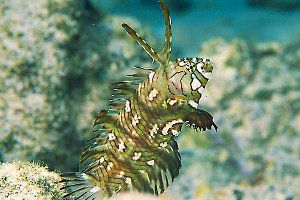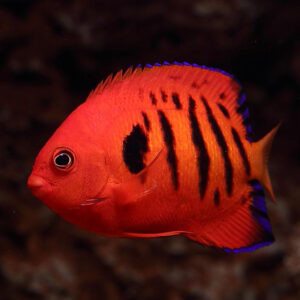Dragon Wrasse, Novaculichthys taeniourus, also go by the name rock mover wrasse. These fish are highly desirable, and it is clear to see why! Juveniles have laterally compressed bodies and boast prominent fin rays which help break up their profile. The most obvious of which are a long pair of appendages sprouting from the youngster’s head. They are a mix of green shades and covered in white dashes and stripes. Adults look incredibly different. The frilly look disappears as they colour up. Instead, adults have bright white faces, with webs of thin black lines originating from around their eyes. They rest of their body is dark and covered in neat rows of white speckles.
Dragon Wrasse, Novaculichthys taeniourus, Ecology.
Dragon Wrasse live in the Indo Pacific and range from: South Africa, the Red Sea, Hawaii, Japan and Tuamoto islands. They occur over: sand, rubble, reef flats, seaward slopes and lagoons. The intricate structures on the reef help the fish avoid predation. Failing that, the Dragon Wrasse will also quickly disappear by burying themselves in the sediment. Juveniles use their unique morphology to pass themselves off as a piece of algae or debris. This allows them to stay under the radar while they are drifting along.
These fish have extensive diets. They will hunt: worms, crabs, mollusc, brittle stars and urchins. The name rock mover wrasse comes from their foraging behaviour. As they overturn surprisingly large stones while rummaging around for prey. In the wild, Dragon wrasse can be kept company by opportunistic fish, making the most of the easy meals uncovered by the wrasse.
Dragon Wrasse are also protogynous hermaphrodites. Which means that, when they get old enough, breeding females turn into a male. As a result, all juveniles are immature females.
Rock Mover Wrasse in the Aquarium.
It is important to copy the natural environment by providing plenty of nooks and crannies. There should also be a good sand bed for the wrasse to hide and sleep in. Hobbyists should get a jump guard to stop any unfortunate losses.
Dragon Wrasse do best when fed a varied diet. They will accept enriched frozen mysis shrimp and enriched frozen brine shrimp. They will also devour live foods, such as copepods and amphipods, that can be cultivated in attached refugium. Over time they will accept high-quality pellet or flake. We adapt all our wrasse to aquarium life before they leave us. We focus on their health, and most are eating a good quality flake food and/or pellet, such as JBL Maris, before being offered for sale.





Reviews
There are no reviews yet.